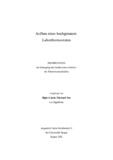Citation link:
https://nbn-resolving.org/urn:nbn:de:hbz:467-315| DC Field | Value | Language |
|---|---|---|
| dc.contributor.author | Ney, Michael | - |
| dc.date.accessioned | 2019-09-02T09:53:17Z | - |
| dc.date.available | 2005-09-19T12:12:12Z | - |
| dc.date.available | 2019-09-02T09:53:17Z | - |
| dc.date.issued | 2002 | - |
| dc.description.abstract | Ziel der Arbeit war die Konstruktion eines Laborthermostaten zur hochgenauen Thermostatisierung von Messvorrichtungen. Die Temperaturstabilität sollte im Bereich eines Millikelvins oder darunter liegen. Dabei sollte eine gewisse Flexibilität gegeben sein, d.h. der Thermostat sollte nicht nur für eine bestimmte Apparatur ausgelegt werden, sondern bei verschiedenen Messzellen angewendet werden können. Dabei wurde versucht, die Regelung an die jeweiligen Verhältnisse der Regelstrecke in Hinsicht auf Tot- und Verzögerungszeiten anzupassen. Dazu wurden unterschiedliche empirische Verfahren getestet. Weiterhin wurde versucht, aufwendigere Adaptionsverfahren zur Optimierung der Parameter zu nutzen. Unter Verwendung von Simulationsprogrammen wie Scilab und des Mathematikprogramms Mathematica wurde versucht, ein Modell zu erstellen, mit dessen Hilfe z.B. Reaktionen des Thermostates auf Sollwertänderungen nachvollzogen werden können. An einer Apparatur zur Messung des Cotton-Mouton-Effektes wurde eine Messreihe über einen größeren Temperaturbereich aufgenommen, wobei der Thermostat zur Temperierung der Messzelle benutzt wurde. Es gelang auf diese Weise näher an den isotrop-nematischen Phasenübergang eines Flüssigkristalls heranzukommen, als es mit handelsüblichen Thermostaten möglich war. Die sehr große Temperaturabhängigkeit der Cotton-Mouton Konstante in der Nähe der Phasenumwandlung ist ein guter Indikator für die Temperaturstabilität eines Thermostaten. | de |
| dc.description.abstract | The aim of this work was the development of a laboratory thermostat for the highly precise temperature control. The fluctuation of the temperature should be less than a millikelvin. The thermostat was designed to control the temperature of various measuring devices. To achieve this, the parameters of the controller had to be ajusted to different properties of the controlled system, such as various dead-times or delay-times. For this purpose, different empirical methods were tested. Further it was tried to optimise the parameters in a more theoretical way. This was attempted by using the simulation program Scilab and the mathematics program Mathematica. With the aid of those programs, a model could be developed wich allows e.g. to investigate reactions of the thermostat to changes in the nominal value of the temperature or external disturbances. The Cotton-Mouton-Effekt is very sensitive to changes in temperature near the isotropic- nematic phase-transition of a liquid crystal. So it can be used to test the performance of a thermostat.With an equipment for the measurement of the Cotton- Mouton effect a series of measurements was accomplished over a larger temperature range. It could be shown that it was possible to get closer to the phase transition, than it was possible with commercial thermostats. | en |
| dc.identifier.uri | https://dspace.ub.uni-siegen.de/handle/ubsi/31 | - |
| dc.identifier.urn | urn:nbn:de:hbz:467-315 | - |
| dc.language.iso | de | de |
| dc.rights.uri | https://dspace.ub.uni-siegen.de/static/license.txt | de |
| dc.subject.ddc | 540 Chemie | de |
| dc.subject.other | Präzisionsthermostat | de |
| dc.subject.other | Temperaturstabilität | de |
| dc.subject.other | adaptive Regelung | de |
| dc.title | Aufbau eines hochgenauen Laborthermostaten | de |
| dc.type | Doctoral Thesis | de |
| item.fulltext | With Fulltext | - |
| ubsi.date.accepted | 2003-02-06 | - |
| ubsi.publication.affiliation | Fachbereich 8, Chemie - Biologie | de |
| ubsi.subject.ghbs | UZS | - |
| ubsi.type.version | publishedVersion | de |
| Appears in Collections: | Hochschulschriften | |
This item is protected by original copyright |
Page view(s)
385
checked on Nov 28, 2024
Download(s)
286
checked on Nov 28, 2024
Google ScholarTM
Check
Items in DSpace are protected by copyright, with all rights reserved, unless otherwise indicated.


